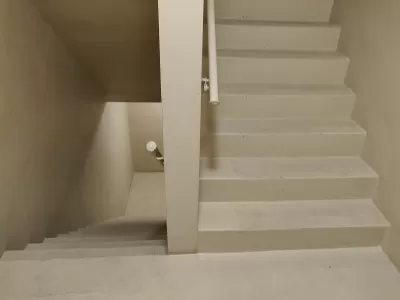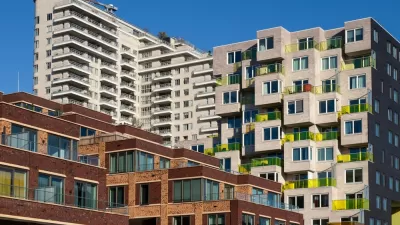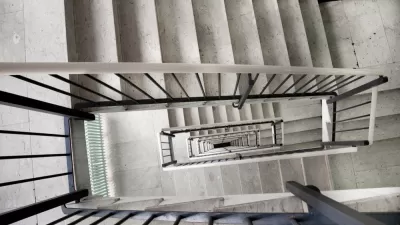U.S. building codes mandate two staircases in multi-story buildings, but some argue this requirement reduces affordability and encourages wasteful, uninspired design.

A group of architects and developers led by architect Michael Eliason is arguing against building codes that mandate more than one staircase in apartment buildings, saying that the requirement "produces smaller, more unpleasant, more expensive apartments in larger buildings full of wasted space. As Henry Grabar notes in an article for Slate, "Most American apartment buildings over four stories are required to include two means of egress from every apartment" for fire safety purposes. But Eliason argues that buildings in other countries that permit one-staircase construction are no less safe from fire.
Eliason observes that when you require every apartment to connect to two staircases, you all but ensure those units are built around one long double-loaded corridor, to give all residents access to both stairways. You tilt the scales in favor of larger floor plates in bigger buildings, because developers need to find room for two stairways, and connect them—and then compensate for the unsellable interior space consumed by the corridor.
Single-staircase advocates argue that second staircases hinder affordability and construction of "missing middle housing," while building fires are much less common than when the rules were put in place. Currently, Seattle is the only U.S. city that permits single stairs in buildings as tall as six stories.
FULL STORY: The Single-Staircase Radicals Have a Good Point

Maui's Vacation Rental Debate Turns Ugly
Verbal attacks, misinformation campaigns and fistfights plague a high-stakes debate to convert thousands of vacation rentals into long-term housing.

Planetizen Federal Action Tracker
A weekly monitor of how Trump’s orders and actions are impacting planners and planning in America.

San Francisco Suspends Traffic Calming Amidst Record Deaths
Citing “a challenging fiscal landscape,” the city will cease the program on the heels of 42 traffic deaths, including 24 pedestrians.

Defunct Pittsburgh Power Plant to Become Residential Tower
A decommissioned steam heat plant will be redeveloped into almost 100 affordable housing units.

Trump Prompts Restructuring of Transportation Research Board in “Unprecedented Overreach”
The TRB has eliminated more than half of its committees including those focused on climate, equity, and cities.

Amtrak Rolls Out New Orleans to Alabama “Mardi Gras” Train
The new service will operate morning and evening departures between Mobile and New Orleans.
Urban Design for Planners 1: Software Tools
This six-course series explores essential urban design concepts using open source software and equips planners with the tools they need to participate fully in the urban design process.
Planning for Universal Design
Learn the tools for implementing Universal Design in planning regulations.
Heyer Gruel & Associates PA
JM Goldson LLC
Custer County Colorado
City of Camden Redevelopment Agency
City of Astoria
Transportation Research & Education Center (TREC) at Portland State University
Jefferson Parish Government
Camden Redevelopment Agency
City of Claremont





























